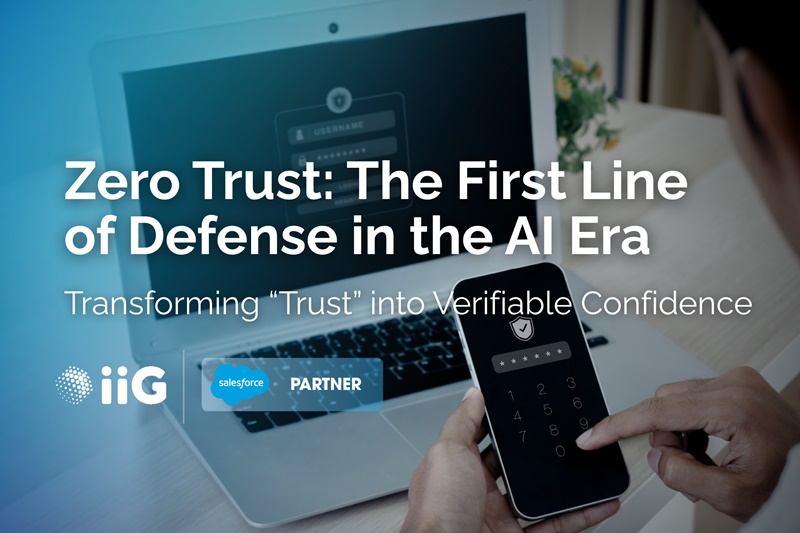Zero Trust: The First Line of Defense in the AI Era
17 Oct 2025

Transforming “Trust” into Verifiable Confidence
In an era where AI and cloud technology drive every aspect of business, organizational data no longer resides solely within internal servers.
It now lives across SaaS (Software as a Service) platforms such as Salesforce, Microsoft 365, and Google Workspace, connecting people, processes, and devices seamlessly across boundaries.
This interconnected environment has made traditional security models—those that implicitly trust everything inside the network perimeter—no longer sufficient.
Why “Trust by Default” Is No Longer Safe
In the past, corporate networks were built on the assumption that everyone inside the system is trustworthy. But with the rise of external connections—remote work, API integrations, and personal device access (BYOD)—that assumption has become a major vulnerability that attackers can easily exploit.
Examples include:
- Employees logging in via public Wi-Fi without multi-layer authentication
- Third-party apps connected to Salesforce requesting Full Access without verification
- Attackers impersonating internal users to access sensitive customer data
This is why the Zero Trust framework was developed: to shift the focus of security from network boundaries to user behavior and access privileges across every action and device.
What Is Zero Trust?
Zero Trust is a cybersecurity framework based on the principle of “Never Trust, Always Verify.”
Every access attempt—whether from inside or outside the organization—must undergo strict authentication, identity verification, and authorization before approval.
The Three Core Principles of Zero Trust
- Verify Explicitly – Always authenticate and validate every access request.
Each login must verify both the user’s identity and the compliance of their device. - Least Privilege Access – Grant only the access necessary to perform a task.
Minimize exposure by restricting users and systems to the minimal permissions required. - Assume Breach – Always operate as if a breach has already occurred.
Build detection and response mechanisms that can react instantly to anomalies.
This approach not only prevents attacks but also empowers organizations to see and control every connection in real time.
Applying Zero Trust to Salesforce
For organizations using Salesforce as the hub of customer and operational data, Zero Trust can be implemented through three key steps:
- Multi-Factor Authentication (MFA)
Enable MFA for all users—especially administrators and privileged accounts—to prevent unauthorized access. - Access Control
Regularly review user and third-party app permissions based on the Least Privilege principle.
Define and enforce Access Policies via Salesforce Security Center 2.0 to ensure consistent protection across all orgs. - Continuous Monitoring
Use tools like Event Monitoring and Transaction Security Policies to detect unusual activities, such as mass data downloads, logins from unknown IP addresses, or permission changes.
Zero Trust and the Security of AI Agents
As organizations begin adopting AI Agents (such as Salesforce Agentforce) to interact with customers and process data,
Zero Trust becomes even more crucial—because AI itself can access, analyze, and act on sensitive information.
Key practices include:
- Defining clear data boundaries for AI access
- Using Named Credentials or OAuth Tokens for agent identity verification
- Monitoring AI behavior through real-time activity tracking systems
Zero Trust: The Foundation of Trust in the Modern Era
In a world where cyber threats evolve every second, security is no longer about building walls—
it’s about establishing verifiable trust.
Zero Trust enables organizations to:
- Protect at the user level
- Gain visibility into every access and activity across systems
- Respond swiftly to any anomalies
Summary: Zero Trust — The Heart of SaaS Security in the AI Era
- Shift from implicit trust to verified trust in every interaction
- Enforce MFA and Least Privilege Access as non-negotiable security standards
- Leverage Salesforce tools such as Security Center, Event Monitoring, and Shield to build a comprehensive Zero Trust framework
By starting with a strong Zero Trust foundation, your organization can confidently face cyber threats in the AI era and build lasting customer trust grounded in verified security.
Ready to strengthen your Salesforce security with Zero Trust?
Talk to iiG’s experts to assess your readiness and design a security strategy tailored for your organization.
👉 Click here to contact iiG’s Salesforce experts